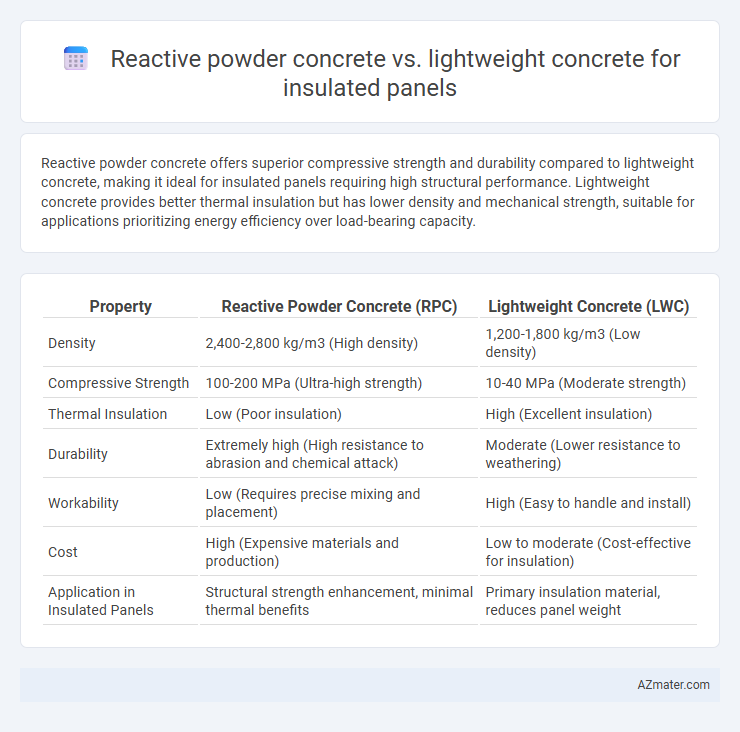Reactive powder concrete offers superior compressive strength and durability compared to lightweight concrete, making it ideal for insulated panels requiring high structural performance. Lightweight concrete provides better thermal insulation but has lower density and mechanical strength, suitable for applications prioritizing energy efficiency over load-bearing capacity.
Table of Comparison
| Property | Reactive Powder Concrete (RPC) | Lightweight Concrete (LWC) |
|---|---|---|
| Density | 2,400-2,800 kg/m3 (High density) | 1,200-1,800 kg/m3 (Low density) |
| Compressive Strength | 100-200 MPa (Ultra-high strength) | 10-40 MPa (Moderate strength) |
| Thermal Insulation | Low (Poor insulation) | High (Excellent insulation) |
| Durability | Extremely high (High resistance to abrasion and chemical attack) | Moderate (Lower resistance to weathering) |
| Workability | Low (Requires precise mixing and placement) | High (Easy to handle and install) |
| Cost | High (Expensive materials and production) | Low to moderate (Cost-effective for insulation) |
| Application in Insulated Panels | Structural strength enhancement, minimal thermal benefits | Primary insulation material, reduces panel weight |
Introduction to Reactive Powder Concrete and Lightweight Concrete
Reactive Powder Concrete (RPC) is an advanced cementitious composite known for its ultra-high strength, durability, and dense microstructure achieved through optimized particle packing and steel fiber reinforcement. Lightweight Concrete, characterized by its reduced density using lightweight aggregates such as expanded clay or shale, offers enhanced thermal insulation and lower structural load for insulated panels. Both materials provide unique benefits for insulated panel applications, with RPC excelling in mechanical performance and Lightweight Concrete optimizing thermal efficiency.
Composition and Material Properties
Reactive powder concrete (RPC) features a dense composition of fine powders including silica fume, quartz sand, and high-strength cement, creating exceptional compressive strength above 200 MPa and low permeability. Lightweight concrete incorporates lightweight aggregates such as expanded clay or shale, resulting in lower density (typically 800-1850 kg/m3) and enhanced thermal insulation properties with reduced thermal conductivity around 0.1-0.3 W/m*K. RPC offers superior mechanical performance and durability, while lightweight concrete provides better insulation and reduced structural load for insulated panel applications.
Structural Strength and Load-Bearing Capabilities
Reactive powder concrete (RPC) exhibits superior structural strength and load-bearing capabilities compared to lightweight concrete, making it ideal for insulated panels requiring high durability and resistance to mechanical stress. RPC's dense microstructure and enhanced compressive strength typically range from 120 to 200 MPa, far exceeding lightweight concrete's standard 8 to 25 MPa, which is limited by its porous composition. Insulated panels utilizing RPC provide enhanced load distribution and reduced deflection under heavy loads, supporting more demanding architectural and engineering applications.
Thermal Insulation Efficiency
Reactive powder concrete (RPC) offers superior compressive strength but has limited thermal insulation efficiency compared to lightweight concrete, which contains air-entrained aggregates that significantly reduce thermal conductivity. Lightweight concrete panels enhance energy efficiency in buildings by providing better heat retention and minimizing thermal bridging due to their lower density and higher porosity. Insulated panels using lightweight concrete achieve a more effective thermal barrier, making them preferable for applications targeting improved thermal insulation performance.
Durability and Longevity in Insulated Panels
Reactive powder concrete (RPC) offers superior durability and longevity in insulated panels due to its ultra-high strength, low porosity, and enhanced resistance to environmental degradation compared to lightweight concrete. Lightweight concrete, while beneficial for thermal insulation and reducing structural load, generally exhibits lower compressive strength and higher permeability, leading to potential durability challenges in harsh conditions. The dense microstructure of RPC minimizes microcracking and chloride ion penetration, significantly extending the lifespan of insulated panels in demanding applications.
Weight Considerations and Panel Handling
Reactive powder concrete (RPC) exhibits significantly higher density, typically around 2400 kg/m3, resulting in heavier insulated panels that may require reinforced handling equipment and increased labor effort during installation. In contrast, lightweight concrete panels, with densities ranging from 800 to 1600 kg/m3, offer reduced weight, enhancing ease of transportation and installation while maintaining adequate structural performance for insulated applications. The substantial weight difference impacts not only the logistical aspects but also the design of support structures, making lightweight concrete panels more favorable for projects aiming to optimize weight considerations and improve panel handling efficiency.
Cost Analysis: Production and Installation
Reactive powder concrete (RPC) offers higher compressive strength and durability but incurs significantly greater production costs due to specialized materials and processes, making it less cost-effective for insulated panels compared to lightweight concrete. Lightweight concrete reduces both material and transportation expenses because of its lower density while enabling faster and easier installation due to decreased panel weight. Evaluating cost analysis reveals lightweight concrete generally provides better economic efficiency for insulated panel applications without compromising thermal insulation performance.
Environmental Impact and Sustainability
Reactive powder concrete (RPC) offers superior durability and strength, reducing material usage and extending the lifespan of insulated panels, which contributes to lower environmental impact over time. Lightweight concrete incorporates natural or synthetic aggregates, leading to reduced thermal conductivity and improved energy efficiency in buildings, enhancing sustainability by decreasing heating and cooling demands. Both materials present sustainable advantages: RPC minimizes resource consumption through high performance and longevity, while lightweight concrete optimizes insulation and reduces embodied carbon through lighter, eco-friendly aggregates.
Application Suitability in Construction Projects
Reactive powder concrete (RPC) offers exceptional compressive strength and durability, making it ideal for structural insulated panels requiring high load-bearing capacity and resistance to harsh environmental conditions. Lightweight concrete provides superior thermal insulation and reduced dead load, which benefits applications demanding energy efficiency and ease of handling in panel installation. Choosing between RPC and lightweight concrete depends on project-specific priorities such as structural performance versus insulation needs and overall weight constraints in construction design.
Future Trends in Insulated Panel Technology
Reactive powder concrete offers superior compressive strength and durability, making it ideal for high-performance insulated panels in future construction. Lightweight concrete provides enhanced thermal insulation and reduced structural load, supporting energy-efficient building designs. Emerging trends emphasize hybrid solutions combining reactive powder and lightweight concrete to optimize strength, insulation, and sustainability in insulated panel technology.

Infographic: Reactive powder concrete vs Lightweight concrete for Insulated panel
 azmater.com
azmater.com